Research Note
研究ノート
I first encountered glass when I was 18 years old. The first time I ever saw glass melt at 1300 degrees, I felt I saw death. It reflected a world where life could not survive, like the molten interior of a volcano’s crater. However, once the red-hot glass cooled, it conveyed a completely different expression. As it changed into a mystical material that is both transparent and envelops light, as I witnessed the precise moment when the shape was created, I felt a sense of life within glass.
18才の頃だった。初めて1300℃で熔解されたガラスを見たとき、私は死を感じた。それは、火口から見えるマグマのように、生命が存在できない世界に映った。ところが、炎で熱せられた真っ赤なガラスがひとたび冷めると、その姿は一変して違った表情を見せる。透明で光を内包する、神秘的なガラスに変化したとき、私はその物質の生を感じた。まさに形が生まれる瞬間を知った。

Glass Furnace / ガラス溶解炉
The origins always start by chance. A meteor impacted the Libyan desert, turning silica sand into glass. A traveler happening over that same ground found the glass and was fascinated by the existence of this material that held light. The Libyan glass was used for the Tutankhamen's chest decoration, and the evolution of the glass took place on Earth.
起源はいつも偶然から始まっているように思う。偶然、リビアの砂漠に隕石が衝突して、シリカ (砂漠の砂) がガラスに生まれ変わった。また、偶然、その地を歩いていた旅人)がそのガラスを拾い、光を内包するガラスの存在に心を奪われてしまった。そのリビアのガラスはツタンカーメン王の胸飾りに用いられ、その後、地球上でガラスの進化が起こる。
References/参考文献
Earth and Planetary Science Letters Volume 382, 15 November 2013
National Geographic News、彗星の地球衝突の痕跡、エジプトで発見、2013.10.15
How We Got to Now: Six Innovations That Made the Modern World, Steven Johnson, 2014
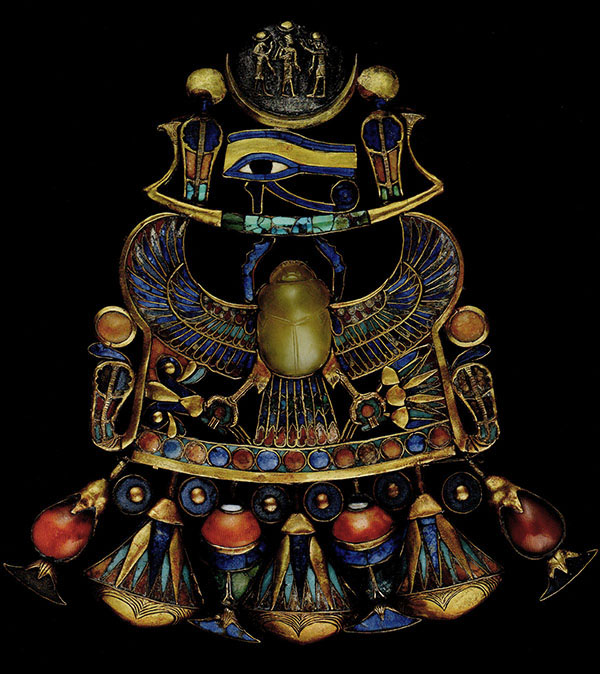
Pectoral with a Winged Scarab / 有翼スカラベ付き胸飾り
From TUTANKHAMUN catalog 2012/ ツタンカーメン展の図録2012使用(P.121)
The history of glass has converged with the development of our civilization. During the Roman Empire, glassmakers succeeded in producing completely transparent glass, accelerating the glass revolution. Glass was then polished into a thin disk, forever changing the ways in which we are able to observe the world around us. With the birth of the lens, people further embraced reading, and the printed word spread. The glass lens enabled the creation of microscopes and telescopes. With the inventions, we came to know of worlds, both great and small, which humans could not previously observe.
常にガラスの歴史は、我々の文明と大いに関わっている。ローマ帝国時代、ガラス職人が透明なガラスの生成に成功し、ガラスの革命は加速した。ガラスを薄い円盤に磨き上げ、目で覗いたのである。この眼鏡の誕生で、人々は文字を読むことに目覚め、印刷技術が発展し、同時に眼鏡は、顕微鏡や望遠鏡をも生み出した。その発明により、人間は手に届くことができなかった世界を知るのである。
References/参考文献
How We Got to Now: Six Innovations That Made the Modern World, Steven Johnson, 2014

I myself could not live without glasses.
自分自身も眼鏡がないと生活ができなくなってしまった。
Despite such significant advances in civilization and technology, glass production still requires a large amount of energy. Even today, glass cannot be melted without continuing to burn the fossil fuel on earth.
これだけ文明やテクノロジーが進歩しても、未だに、ガラスの生成は大量のエネルギーを必要としている。現在でも、地球にある化石燃料を燃やし続けないとガラスを熔かすことができない。

Gas Furnace / ガス溶解炉
Uranium glass, which I frequently utilize from 2011, contains trace amounts of uranium. This makes the glass emit a beautiful fluorescent glow under ultraviolet light and other energy sources. Production of uranium glass began in Czechoslovakia around 1830 and spread to other parts of Europe, where products such as tableware and vases were made from uranium glass. However, uranium glass production all but ceased after uranium became a raw material used for atomic bombs and nuclear power generation. The high energy content of uranium has both positive and negative sides. The atomic bomb killed, maimed, and sickened tens of thousands of people. Even uranium’s use in the form of nuclear power generation has inflicted severe damage on humankind, as demonstrated by the Chernobyl and Fukushima disasters. It is also true, however, that many of us today benefit significantly from energy produced from uranium.
2011年から作品に用いているウランガラスは、ごく微量のウランを含有し、紫外線などのエネルギーを与えられるととても綺麗な蛍光を発する。このガラスの生産は、1830年頃にチェコで始まり、ヨーロッパ各地で食器や花瓶などに使用されていたが、ウランが原子力エネルギーの原料として、原子力爆弾や原子力発電に利用されるようになったため、今ではほとんど生産されていない。ウランの大きなエネルギーには正と負の両面があり、軍事利用された原子爆弾では多くの被害者が生まれ、平和利用を目的とした原子力発電でさえ、チェルノブイリや福島の事故のように人類に多大な被害を与えた。しかし現在も大きなエネルギーの恩恵を受けていることも事実である。
References/参考文献
ウィキペディア フリー百科事典、ウランガラス、ウランガラスの歴史
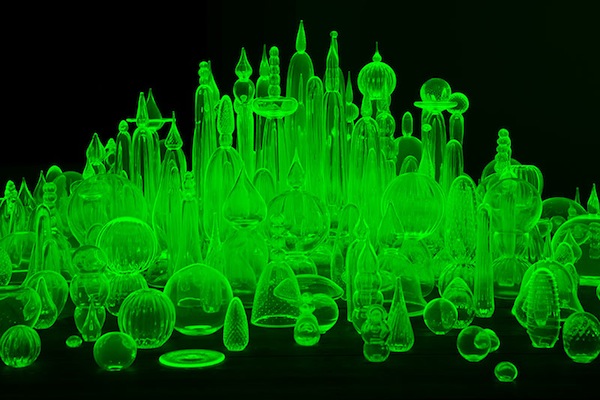
"The Beginning of the End of the World" / 《世界の終わりの始まり》
Gallery O2 in Kanazawa, Japan / Gallery O2(金沢)
I have been observing the Gifu Chō since 2016 when I moved to Toyama. The Luehdorfia Japonica is a small species of butterfly in the subfamily Parnassiinae of Papilionidae which is only found in Japan. The Gifu Chō, a primitive species hardly changed in appearance from ancient times, has long inhabited the Japanese archipelago and can be found only on Honshu Island. In the larval stage, they roam the land eating plants such as Asarum Nipponicum (Japanese wild ginger). Adults emerging from their cocoons appear during the early spring and fly around the low mountain ranges. The ancestors of the Gifu Chō are believed to have inhabited the region for over 30 million years and survived the Ice Age. They remain today, representing the cycles life and death since ancient times. Beginning in the 1960s and 1970s, many Gifu Chō suddenly began losing their natural habitats due to the developments of the satoyama regions (interstitial spaces between arable flatland and mountain foothills) and the deterioration of vegetative environments. They are extinct in areas such as Tokyo and the Wakayama Prefecture.
富山に住み移った2016年から、ギフチョウの観察を始めている。チョウ目アゲハチョウ科ウスバアゲハ亜科に分類される年1化の小型蝶で、日本の固有種である。ギフチョウは、太古から姿があまり変わらない原始的な種であると言われ、古くから日本列島に生息し、本州で見ることができる。幼虫時は大地を歩き回り、地表を匍匐するカンアオイなどの葉を食べ、蛹から羽化した成虫は早春に現れて低山地を飛び回る。ギフチョウの祖先は3000万年前ぐらいから生息していた可能性があり、氷河期をも生き延び、生と死を繰り返しながら今まで生き残っている。60〜70年代頃から里山の開発や植生環境の悪化などで、急速にギフチョウは多くの生息域を失い始め、東京都や和歌山県ではすでに絶滅している。
References/参考文献
ギフチョウの自然史、原聖樹著、1979
ギフチョウはなぜ生きた化石といわれるか、いぬい みのる著、1988
ウィキペディア フリー百科事典、ギフチョウ、保護と問題点
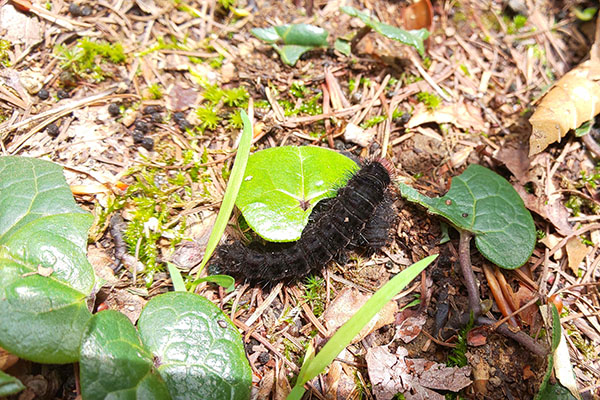
Last Instar Larva of Luehdorfia Japonica / ギフチョウの終齢幼虫
The coronavirus pandemic, which has been ongoing since 2019, has enabled me to spend more time with my family and has brought us closer to nature. One day, while visiting the beach with my family, my son found a small rock with several holes in it. After doing some research, I found out that the stone was made by a bivalve called the piddock, which made holes in the rock to make a home for itself. To me, the holes looked very artificial, as if they had been drilled using tools of human civilization. If it weren't for the pandemic, I wouldn't have made this discovery. And it reminded me of past memories from my childhood of spending time in nature. In fact, I recalled that I had grown up in this natural environment myself. Looking from the present, where I am constantly sharing my life with my smartphone, I was reminded of the sound of the waves, the smell of the ocean, the feel of the things I touch and the nature around me that never ceases to change on a daily basis.
2019年から続くコロナ禍が、家族との時間を作り、僕らと自然の距離を近くさせた。ある日、家族で訪れた海岸で、息子が穴の開いた小石を見つけてきた。調べてみるとカモメガイという二枚貝が住処のために穴を掘った石だった。その穴は文明の道具を使って開けたようにとても人工的に見えた。コロナでなかったらそんな発見もしなかった。また、自然の中で子供との時間を過ごすことで、昔を思い出した。実はこの自然の中で自分も育ったのだと思い返した。常にスマホと人生を共にしている現在からすると、波の音や海の匂い、触った物の感触、日々変化の止まない自然が周りにあることに気付かされた。
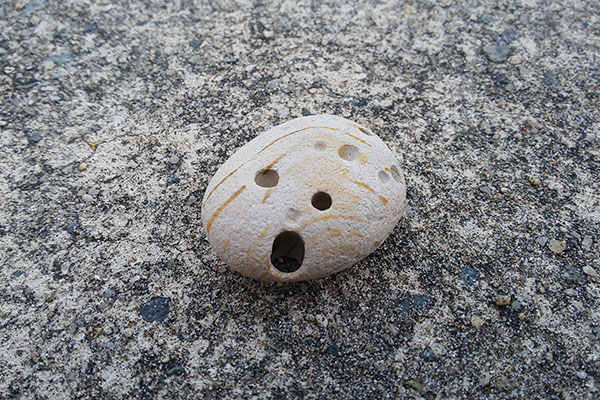
A pebble, the piddock (Penitella) made holes / カメモガイが穴を掘った石
From 2021 summer, I was researching the history and culture of Seto City in Japan, I came across a 25cm tall statue of Maximilian Kolbe made of porcelain. Seto City is a city From 2021 summer, I was researching the history and culture of Seto City in Japan, I came across a 25cm tall statue of Maximilian Kolbe made of porcelain. Seto City is a city renowned for its ceramic industry and after World War I, the city produced and exported figurines called " Novelties " to foreign countries. The statue of Maximilian Kolbe, a novelty made at that time, has been preserved and is still carefully displayed at a Catholic church in Seto City. I am not a Catholic, but I was born in Nagasaki, and my parents told me about the history of the suppression of Christianity and the atom bomb from a young age. And I was troubled by the fact that I could not meet people freely in society due to the COVID-19 pandemic. I spent two and a half years not being able to see my mother who lives far away from me, nor was I able to be there to witness the birth of my daughter, who was born last year. It was in this environment that I came across the Maximilian Kolbe statue and decided that I wanted to leave something behind as an artist. As a glass artist, I can express light (hope) using glass. In the midst of the COVID-19 pandemic, and in a world of war and strife, I thought I could convey something to people through that light. I sent that feeling to land of Poland, where Maximilian Kolbe was born..
2021年の夏から愛知県瀬戸市の歴史や文化をリサーチしていた際、磁器で作られた高さ25cmほどのマキシミリアノ・コルベ像に出会った。瀬戸は窯業の街で、昔、第一次世界大戦後、ノベルティと呼ばれる置物を生産、そして海外に輸出しており、その当時に作られていたノベルティのマキシミリアノ・コルベ像が現在も破棄されずに、瀬戸にあるカトリック教会やその関係者で大切に飾られていた。私自身はカトリック信徒ではないが、長崎で生まれ、小さい頃からキリシタン弾圧や原爆の歴史を親から聞かされており、また、コロナ禍で私は人と自由に対面できない社会に心が沈んでいました。遠く離れた母親にも2年間半会えない日々を過ごし、また去年生まれた私の娘にも出産時に立ち会うことができなかった。そういう環境の中でマキシミリアノ・コルベ像に出会い、芸術家として何か形に残したいと想った。私はガラス作家でもあり、ガラスを用いて光(希望)を表現することができる。コロナ禍の中で、また戦争や争いが絶えない世の中で、その光を通して人々に何かを伝えることができるのではないかと想い、私はマキシミリアノ・コルベさまの生まれたポーランドの地にその想いを送った。
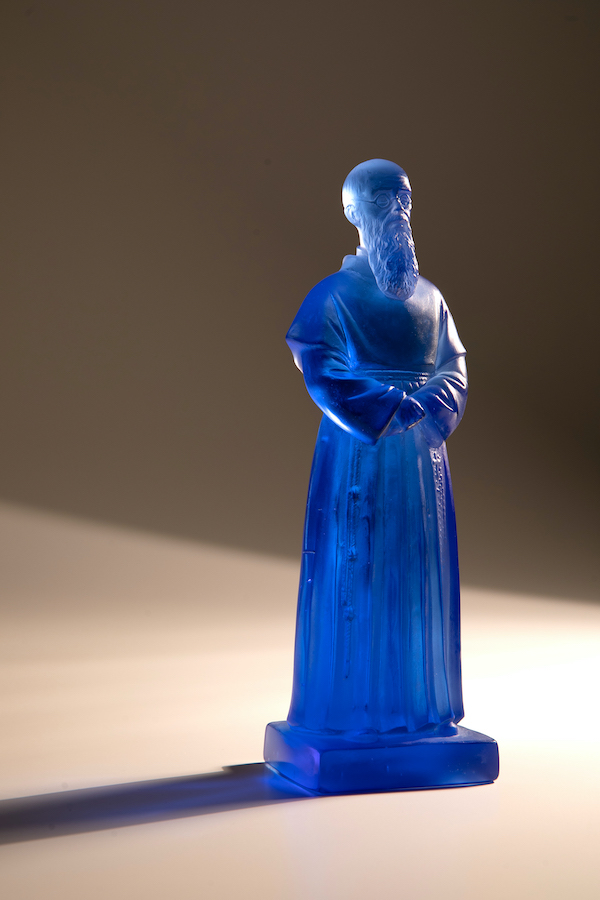
A glass statue of St. Maximilian Kolbe father, I sent to Niepokalanów monastery
ニエポカラノフ修道院に送った聖人マキシミリアノ・コルベ神父のガラス像
© Koichi Matsufuji, All rights reserved
